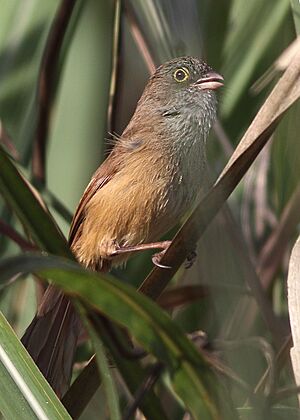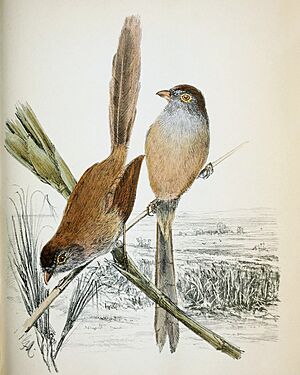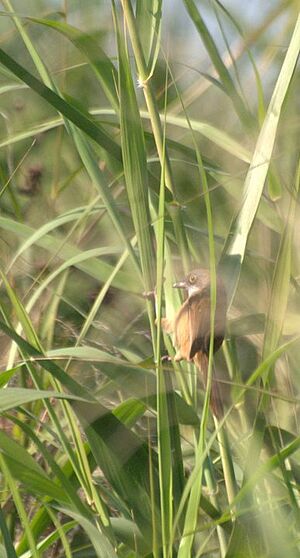Jerdon's babbler facts for kids
Quick facts for kids Jerdon's babbler |
|
|---|---|
 |
|
| Jerdon's babbler in Roing, Grassland Arunachal Pradesh | |
| Conservation status | |
| Scientific classification | |
| Genus: |
Chrysomma
|
| Species: |
altirostre
|
| Synonyms | |
|
Moupinia altirostris |
|
The Jerdon's babbler (its scientific name is Chrysomma altirostre) is a small bird. It belongs to a group of birds called passerines. These birds are found in wetlands and grasslands. You can find them in the Indian sub-continent.
This bird is considered a vulnerable species. This means its numbers are decreasing. It has been on the IUCN Red List since 1994. The Jerdon's babbler is part of the Chrysomma group. This group belongs to the Paradoxornithidae bird family.
The bird is named after Thomas C. Jerdon. He was a surgeon and a naturalist.
Contents
What Jerdon's Babblers Look Like
Jerdon's babblers are about 16–17 cm long. This is about the length of a pen. They look like a mix between some typical warblers and parrotbills. They are not very colorful birds.
These birds have a long tail. They use their tail to balance. This helps them move through thick plants. Their beak is thicker than a warbler's. But it is not as heavy as a parrotbill's.
Their upper body is a buffy chestnut brown. Their belly is a lighter yellowish-brown. The area around their eyes, called the lores, is pale grey. Their throat and chest are also grey. Their tail and a patch on their wing are redder.
Their legs and feet are dark. The top part of their beak is grey. The bottom part is pale. Their eyes are yellowish-brown. A thin ring of greenish-yellow skin goes around each eye.
Male and female Jerdon's babblers look the same. Young birds have more orange on their upper feathers. Their lower beak is pink. Different groups of these birds have small differences. For example, some have richer brown and darker grey colors.
The yellow-eyed babbler (C. sinense) is a relative. It looks brighter than the Jerdon's babbler. It has more vivid colors. It has white where the Jerdon's babbler has grey. It also has a white stripe above its eye. Its legs, feet, and eyes are yellowish. It has an orange-yellow ring around its eye.
Naming and Types
The scientific name Chrysomma altirostre was first used in 1862. Thomas C. Jerdon gave it this name. He found a pale reddish-brown babbler in northern Myanmar.
Later, other names were suggested for similar birds. In 1877, Allan Octavian Hume named a red babbler Pyctorhis griseigularis. He found it in Bhutan. In 1915, Herbert Hastings Harington named an earthy brown babbler Pyctorhis altirostris scindicus. This one was from Sindh, Pakistan.
Today, scientists recognize three main types, or subspecies, of Jerdon's babbler. They are found in different areas:
- C. a. altirostre: This type lives in the Ayeyarwady River area of Myanmar.
- C. a. griseigularis: This type is found in the Terai region. This stretches from western Nepal to northeastern India.
- C. a. scindicum: This type lives in the Indus River area.
Where Jerdon's Babblers Live
Jerdon's babblers live near rivers all year. They like thick reedbeds and tall grasslands. These areas have plants like cogongrass, common reed, and reedmace.
In Pakistan, they live along the Indus River. In Punjab, India, they have been seen in Harike Wildlife Sanctuary. In the Terai region, they are found in Shuklaphanta National Park and Dudhwa National Park.
In northeast India, they have been seen in several national parks. These include Kaziranga, Orang, and Manas. They are also in Dibru-Saikhowa National Park, Majuli, and D'Ering Memorial Wildlife Sanctuary.
In Myanmar, people thought this bird was gone. But it was found again in May 2014. This was in the lower Ayeyarwady floodplain near Yangon. It was also rediscovered in Wakema Township in 2019.
The places these birds like best have tall reeds. These reeds can be several meters high. In the Indus River area, they like hardy sugarcane and kans grass. They also live in stands of ravennagrass. They usually do not like single types of plants or shorter plants. Other grasses are also found where these birds live. These include satintails, giant cane, vetiver, and other types of grass.
How Jerdon's Babblers Behave
The Jerdon's babbler has a soft song. It has 4 to 8 notes. It sounds like chi-chi-chi-chew-chew-chew or tew-tew-tew-tew chew. The last note is often long. Sometimes it starts with a chattering sound.
Birds usually sing in the early morning and evening. They sit straight up on a reed. Their head is slightly raised. Their calls are short sounds like tic or tsik. Sometimes this turns into a series of ts-ts-tsik. This can end with a sad tew sound.
These birds move quietly in groups. They can be pairs, families, or small flocks. A flock might have 10 to 20 birds. They stay in thick, tall grasses and reeds. They usually avoid shorter plants or bushes.
They have a special way of finding food. They perch almost flat on a reed stem. Then they grab a leaf sheath with their beak. They quickly tear off the leaf. This shows small arthropods and other invertebrates. The sound of them tearing dry leaves can be heard from far away.
Protecting Jerdon's Babblers
Jerdon's babbler is not a common bird. Its numbers are thought to be going down. It is not certain if it still lives in Bangladesh. The scindicum type is rare. Its numbers have been falling for many years.
Scientists think there are fewer than 10,000 adult birds left. This means their population has dropped by about 30%. It is expected to keep dropping for at least another ten years.
The reasons for this decline are not fully known. But it is likely due to habitat destruction. People are draining and damming wetlands. This is done for farming and to control floods. These threats are not expected to stop soon. Places where these birds can live are now very rare.
However, some human activities might help. Cutting reeds in a careful way seems okay for the birds. In Pakistan, they are often seen in the Rohri Canal. Large groups are found in reedbeds that have been partly cut or burned. This suggests that if large areas are not completely cleared, human use of reeds might actually make the habitat better. It stops the habitat from getting old and decaying all at once. If there are healthy populations of Phragmites reeds, the birds are likely to survive.




